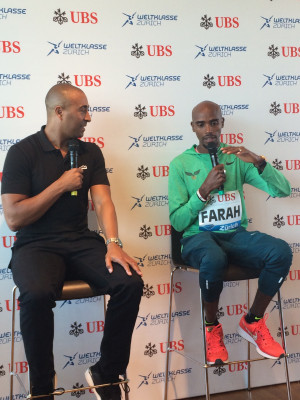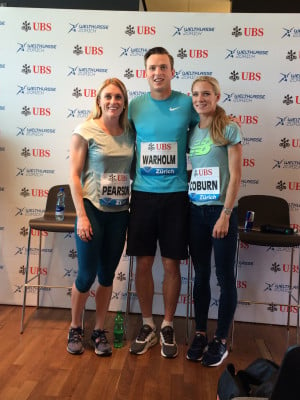A big tidbit from Zurich: Mo Farah thinks he could have run a 5,000 in 12:45 (and an 800 in 1:44-5) had he time trialed one in his prime
Plus Emma Coburn’s Thoughts on the 9:00 Barrier
By Jonathan Gault
August 23, 2017
ZURICH — The first of two Diamond League finals will take place tomorrow at Letzigrund Stadium, but before the stars gather on the track and in the field for the 2017 Weltklasse Zurich meet, they gathered for Wednesday’s pre-meet press conference. In all, eight newly-crowned world champions were in attendance at Letzigrund (plus three more 2016 Olympic champions), including Mo Farah and Emma Coburn.
With Worlds in the rearview mirror and the next global championships 25 months away, the mood was more relaxed than normal, with all of the athletes in high spirits. But with $50,000 on the line for the winner of each event, the competition should be fierce inside the stadium tomorrow night.
While there wasn’t a lot of hard news being broken during the press conferences, there were several interesting nuggets worth sharing, including what Farah thinks he could have run for a variety of distances and when Coburn first thought she could challenge the 9:00 barrier. I was also able to secure a one-on-one interview with Coburn, which you can read/watch in a separate article (video here, article coming soon). If you missed the LRC meet preview, be sure to check that out as well: LRC 2017 Weltklasse Zurich Preview: Mo Farah Says Goodbye To The Track, Emma Coburn Chases Sub-9:00 & Elijah Manangoi Looks To Close Out Big Year In 1,500
So without further ado, here’s what you need to know ahead of tomorrow’s meet.
Mo Farah’s hypothetical PRs: 47.xx, 1:45, 12:45
Tomorrow’s 5,000 will be the final track race of Farah’s storied career, and while his medal haul (10 golds, 2 silvers) at the global level is unprecedented for a distance runner, the big knock on him in terms of GOAT (greatest of all time) discussions is his modest personal bests at 5,000 and 10,000.
Looking at the all-time lists, Farah’s best PR in an Olympic event is his 3:28.81 for 1500 (T-10th all-time) even though he never won a single medal in that event. He’s 31st on the 5,000 list (12:53.11) and 16th on the 10,000 list (26:46.57).
While his 1500 best is an accurate representation of what Farah could do at his best in ideal conditions, the other two — particularly the 5,000 — are not. Today, Farah was asked what he thought he was capable of at his peak in an all-out 5,000, as well as two distances he almost never raced (400 and 800).
Farah said that he felt he was at his fittest in 2013 — when he set that 1500 pb and swept the 5,000 and 10,000 at Worlds in Moscow. Farah won four of his five 5,000s that year, but his fastest time (13:05.88) came in a defeat as he lost to Edwin Soi at the Pre Classic after battling illness before the meet.
“That year, I think I could have run probably about 12:45, 12:46,” Farah said. “It all just depends on how the race is run and how far the rabbit could help.”
As for the 800, Farah noted that most of the men who have broken 3:30 can also run 1:44 or 1:45 for 800 “so I think that’s what I could have run.” Farah’s last 800 came in 2008, when he ran his PR of 1:48.24 in Lugano, Switzerland, but it should be noted that Farah closed the final 800 of the 2015 World Championship 5,000 final in 1:48.6.
Farah has never raced a 400, but said he has broken 50 seconds in practice. He wasn’t sure about what he could run in an all-out 400 but said he believed he would be able to beat the world’s best women. “Maybe 47?” Farah said. “I should be able to just beat them.”
MB: Mo Farah told us today he thinks he could have run 12:45 in his prime…. Agree or disagree?
Farah breaks down his loss to Muktar Edris: “Maybe I should have been in the first spot [on the final lap] but I had nothing left”
In the immediate aftermath of the 5,000 final in London, Farah’s first defeat at a global championship in six years, he felt that his loss was due in part to Ethiopian team tactics. We at LetsRun.com weren’t convinced of that (see this article for our full analysis) but Farah admitted this afternoon that Edris was the better man on the day and, after reviewing the race on video, says he would have not have done much differently if given a do over.
“Looking back on it, tactically, maybe I should have been in the first spot [on the last lap] and holding that point going into it, but I had nothing left,” Farah said. “I was tired. I was working hard. At that point, I was thinking, Yeah, if I carry on this, I won’t make it to the finish line.”
One reason for that was the fatigue Farah carried into the race. In the past, Farah has had some energy between the 10k and 5k and major championships, but this time he was very quiet as he recovered for the 5k and said his wife, Tania, noticed. His 26:49.51 winning time was just three seconds off his PR and the fastest time in the world in over three years.
“I have looked back and [learned] a little bit [from watching the 5,000] but it’s different,” Farah said. “Most of the guys didn’t do 50 laps round the track. That 10k did take tons out of me, more than any other championship.”
Emma Coburn said that until last year, she felt sub-9:00 was “probably never attainable” for her
Many top athletes thrive off of competition, but for Coburn, her competitors are essential to elevating her own performance. One of the reasons she was able to win the world title two weeks ago in London was because she ran most of the race with fellow American Courtney Frerichs, a woman she has never lost to (10-0 overall).
“Seeing Courtney right there again provided a little bit of motivation like, Hey, she’s doing this, you can it too,” Coburn said after her victory.
Coburn has come around to the idea of breaking 9:00 in the steeple in a similar fashion. Before last year, only one woman in history, Russia’s Gulnara Galkina, had ever broken 9:00, and that came back in 2008. From 2009 to 2015, no one even broke 9:05. But since the start of 2016, both Ruth Jebet and Celliphine Chespol have joined the sub-9:00 club, with two other women running 9:00. That has changed Coburn’s perspective significantly.
“The 9:00 barrier is something that, prior to the Rio Olympics, prior to a year ago, was almost next to unheard of in the steeplechase. It had been done a handful of times but it wasn’t an area where women consistently found themselves.
“So up until last year, it felt to me a like distant, distant goal, probably never attainable. And then when my competitors started breaking that and now the world record is 8:52, it definitely feels more real if there’s all these other women that can do it now.
“It’s kind of like when Bannister broke 4:00 and then everyone started breaking it. It is this mental barrier that you have in your head and it helps having opponents break it.”
Considering Coburn ran 9:02.58 in London — and beat two sub-9:00 women in that race — she knows it’s possible now.
“It’s definitely on my radar, if not tomorrow, then next season for sure. The next big goal of mine, for sure, is 9:00.”





